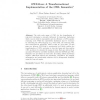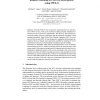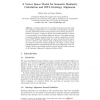137 search results - page 2 / 28 » Modeling Ontologies using OWL, Description Graphs, and Rules |
WWW
2004
ACM
14 years 5 months ago
2004
ACM
Although the OWL Web Ontology Language adds considerable expressive power to the Semantic Web it does have expressive limitations, particularly with respect to what can be said ab...
IADIS
2003
13 years 6 months ago
2003
Ontologies in a web setting, particularly those used in a group context (such as a virtual community), need to be flexible and open to changes that reflect the evolution of knowle...
ISPA
2005
Springer
13 years 10 months ago
2005
Springer
The wide scale usage of OWL for the formalization of real-world ontologies is currently influenced by important limitations which concern both its expressivity and the efficiency ...
KIVS
2005
Springer
13 years 10 months ago
2005
Springer
Abstract. Semantic Web services envision the automated discovery and selection of Web services. This can be realised by adding semantic information to advertised services and servi...
DEXA
2006
Springer
13 years 8 months ago
2006
Springer
Ontology alignment (or matching) is the operation that takes two ontologies and produces a set of semantic correspondences (usually semantic similarities) between some elements of ...



